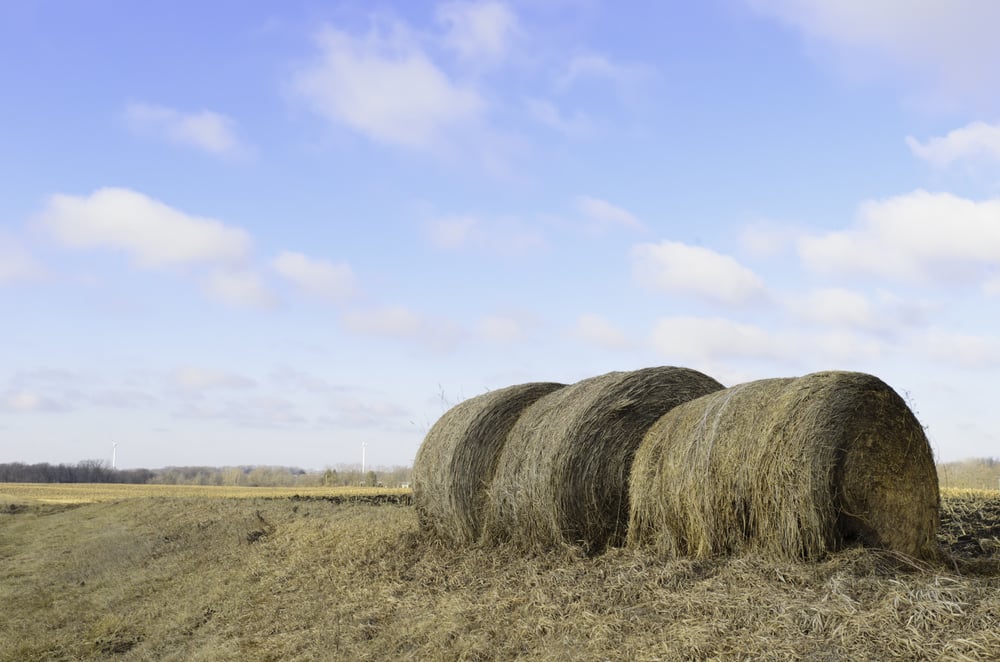Beef Cattle Pasture and Hay Outlook
By Todd Litten and Lindsay Humphrey
Last year, in the United States, cattle production contributed the largest portion of total agricultural cash receipts for commodities. Of the $462 billion, cattle contributed 17% to that number (USDA ERS). Even though the State of Indiana contributes to that number, it’s not their largest agricultural commodity.
“Most cattle operations are part-time farms that also grow row crops, or the owner has a full-time job in town,” said Todd Litten, who’s a farm manager and real estate agent for Halderman but also raises beef cattle at home part-time. “Of course, there are some full-time cattle operations, but they’re not that common in this area or in the state.”
Very few properties that Halderman manage even have cattle as part of their operation. However, they’ve helped connect owners with renters to fill up unused pastureland. However, in the last ten years, rolling hills of green pastures dotted with livestock dwindled.
Back in 2009, $3/bushel corn didn’t inspire producers to plant their pastures to row cops. When that number more than doubled just three years down the road, planters found themselves on uncharted territory and tilled some of the pasturelands to produce corn and soybeans.
“A lot of those rolling hill pastures were turned over to no-till, row crops because of that jump in price,” Litten said. “It takes significantly less time to raise row crops than cattle. Several thousand acres were converted to row crops back then [2012].”
Profit margins for cattle production in recent years certainly dwindled. There’s no secret about that. Litten said that the industry is making a slow but steady comeback. Constraints on inputs like high fertilizer prices, feed costs, pastureland, and hay could easily be contributors to this.
“Pastures have been a little bit slow growing this year mostly because of the cooler temperatures,” Litten explained. “We’ve had about average rainfall, so that’s not been a problem this year. Typically, you want to let the pasture get some growth before letting animals out on it, and it seems like everyone is doing that in my area and what I’ve seen around the state.”
It’s a small but meaningful practice that makes cattle producers significant contributors to conservation efforts across the nation. Even just a few days of extra growth on a pasture can make all the difference if a period of drought shows up in the summer months.
Like many of his peers in the state, Litten takes his role as a conservationist to heart and allows that to influence many of his decisions.
“In my specific situation, owning cattle allows us the opportunity to take better care of our land,” Litten said. “With the type of soils and rolling topography we have here, leaving the soil bare in the winter means it’s going to erode easily. Keeping a good sod cover with permanent pasture or planting cover crops that those cattle can graze on through the winter keeps the land strong and feeds the cattle at the same time.”
 A mild winter meant hay supplies from last summer won’t need to be replenished as in years past. It’s one of those pleasant, not often realized surprises for anyone raising livestock.
A mild winter meant hay supplies from last summer won’t need to be replenished as in years past. It’s one of those pleasant, not often realized surprises for anyone raising livestock.
“I think the coming hay crop is looking good, and it should be in the normal range for this first cutting,” Litten said. “I do know the alfalfa weevils are bad again this year. It’s a worm that eats the leaves of the plant, and that hurts production. Usually, they’re only in the first cutting because after mowing down the plant, they die off.”
Even though Litten raised cattle most of his life, he’s always looking for more information to do it better. Beef Magazine, Drover’s Journal, and his county extension service are some of his favorite resources. Recently, he discovered that Facebook can provide a wealth of information if you know where to look.
“I’ve joined a cattle group on Facebook, and it’s been really interesting,” he said. “There are a lot of people on there just starting out, and they’ll ask questions that make it clear they don’t have much experience, but then the members provide a lot of great information.”
It’s been through this same thread that Litten’s noticed a common trend among beef consumers: they want to know where their beef comes from and how it was raised. Many of Litten’s own customers are cut from this same cloth and visit his operation to fulfill those farm-to-table storylines.
“After people come out to the farm, it seems like you’re a little more willing to pay a good, fair price for those animals. That’s something I noticed a lot since the start of COVID,” Litten added. “Even still, you really have to love raising cattle because it’s a lot of work, but I can’t imagine not having cattle on the farm.”
Halderman Farm Management provides property management services to all types of farms, from row crops to livestock, across 21 states. Please contact your local area representative to learn how Halderman can Help you.
